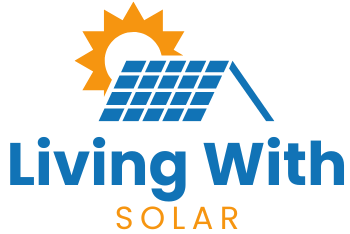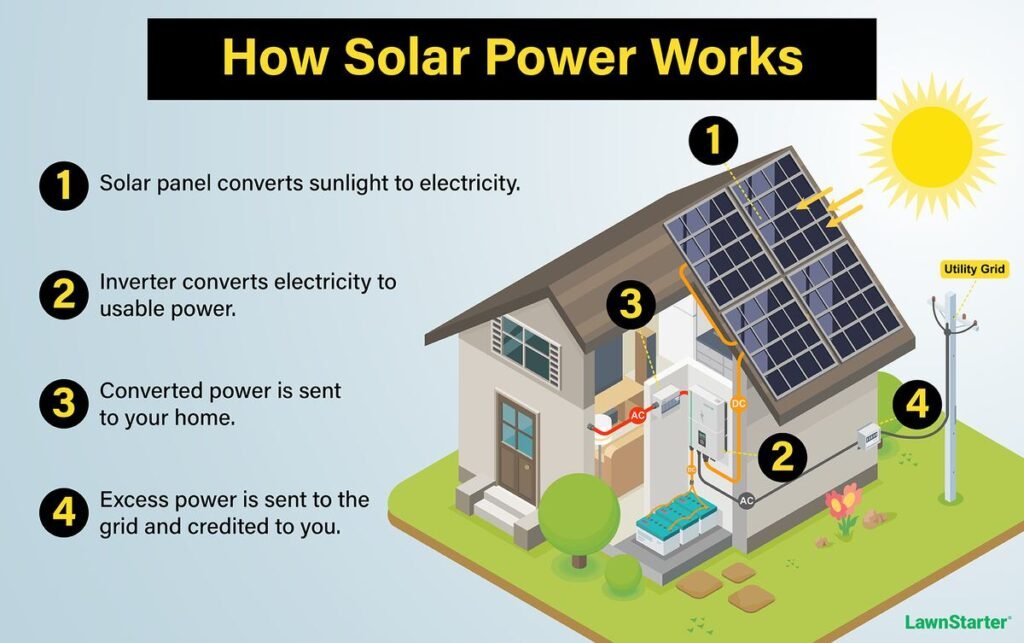Ever glanced up at those shiny panels on rooftops and wondered what they’re all about? Solar power is more than just a buzzword—it’s a way to turn sunlight into electricity.
At its core, solar power is about capturing the sun’s energy and converting it into something we can use in our homes and businesses.
This guide will break down the basics, from how solar panels work to the different types of solar technology out there.
Key Takeaways
- Solar energy is harnessed from the sun and converted into electricity using solar panels.
- The photovoltaic effect is the key process that allows solar panels to generate electricity.
- Solar panels consist of solar cells, inverters, and protective layers to function effectively.
- Different solar technologies include photovoltaic, solar thermal, and concentrated solar power.
- Solar power can be used in residential, commercial, and large-scale applications.
Understanding Solar Energy

The Basics of Solar Energy
Solar energy is all about harnessing the sunlight to make electricity. This energy source is not just abundant; it’s clean and renewable. The sun provides more energy in a single hour than the entire world consumes in a year.
Imagine that! We capture this sunlight using photovoltaic cells in solar panels, which convert it into electricity. This process reduces our reliance on fossil fuels and cuts down on greenhouse gas emissions.
Plus, solar power offers long-term savings on energy bills, which is a big win for both homeowners and businesses.
How Photons Create Energy
At the heart of solar energy is a tiny particle called a photon. These photons are created in the sun’s core through nuclear fusion. When they reach Earth, they hit the solar panels and set off a chain reaction.
The energy from the photons frees up electrons in the panel’s semiconductor material, creating an electric current. This is the start of how solar panels turn sunlight into usable electricity for our homes and gadgets.
The Role of Nuclear Fusion
Nuclear fusion is the sun’s powerhouse. It’s a process where hydrogen atoms smash together under intense pressure and heat to form helium. This reaction releases a massive amount of energy, primarily in the form of photons.
Every second, the sun converts over 500 million tons of hydrogen into helium, sending a constant stream of energy our way. This energy is what we capture and convert into electricity using solar technology.
It’s a fascinating process that powers not just our planet, but potentially our future as well.
The Photovoltaic Effect

Discovery and History
Back in 1839, a young French physicist named Edmond Becquerel stumbled upon something fascinating. He noticed that when he exposed certain materials to light, they generated a small electric current.
This discovery, now known as the photovoltaic effect, laid the groundwork for solar technology. Fast forward to 1954, and we see the first practical solar cell emerge from Bell Labs, thanks to the efforts of Daryl Chapin, Calvin Fuller, and Gerald Pearson.
They crafted a silicon-based cell that could actually power everyday devices. It’s wild to think that what started as a curious observation has evolved into a technology that powers satellites and even spacecraft today.
How Solar Cells Work
So, let’s get into the nitty-gritty of how solar cells actually work. At the heart of a solar cell is a material called silicon, which is a semiconductor. When sunlight hits the solar cell, photons (tiny packets of light) knock electrons loose from their atoms.
This is where the magic happens: the movement of these electrons generates an electric current. Here’s a quick rundown of the process:
- Photons from sunlight strike the solar cell.
- Electrons are knocked loose from the silicon atoms.
- An electric field within the cell guides these free electrons into a current.
This current is direct current (DC), which isn’t what we use in our homes. That’s where inverters come in, converting DC to alternating current (AC), making it usable for our appliances.
Materials Used in Solar Cells
Silicon isn’t the only game in town when it comes to solar cells, but it’s by far the most common. It’s abundant and works well for converting sunlight into electricity.
However, there are other materials like cadmium telluride and copper indium gallium selenide, which are used in thin-film solar cells.
These materials offer flexibility and can be applied in a variety of settings. But silicon remains the superstar, thanks to its efficiency and availability.
The photovoltaic effect is a remarkable process where light, or other forms of radiant energy, hits two different materials in close contact, creating an electrical voltage.
It’s the phenomenon that makes solar power possible, transforming sunlight into electricity we can use every day. Learn more about the photovoltaic effect.
Components of a Solar Panel
Solar Cells and Their Types
When we break down a solar panel, the first thing to look at is the solar cells. These little guys are the heart of the operation. They absorb sunlight and turn it into electricity. Monocrystalline and polycrystalline are the two main types of silicon solar cells.
Monocrystalline cells are made from a single crystal of silicon, which makes them more efficient because electrons have more room to move.
Polycrystalline cells, on the other hand, are made from fragments of silicon crystals melted together. They’re usually less efficient but also less expensive.
The Importance of Inverters
Once the solar cells do their job, the electricity they produce is in direct current (DC) form. But our homes run on alternating current (AC). That’s where inverters come in. They convert DC into AC so you can use the power in your house.
Inverters are crucial because without them, the electricity generated by solar panels would be pretty much useless for home appliances.
Protective Layers and Casings
Solar panels aren’t just about the cells and inverters. They’ve got layers that protect them from the elements. There’s a glass casing on top that shields the cells from rain, snow, and hail.
Underneath, there’s usually an insulation layer and a back sheet to keep things dry and prevent heat loss.
An anti-reflective coating is also applied to the glass to make sure the cells get as much sunlight as possible. It’s like putting on sunglasses, but for the solar cells, to help them work better.
Solar panels are like a sandwich, with layers that protect and enhance the cells inside, ensuring they can efficiently capture sunlight and convert it into electricity.
Types of Solar Technology
When it comes to harnessing the sun’s energy, there are several types of solar technology, each with its unique approach and application. Let’s dive into the main categories.
Photovoltaic vs. Solar Thermal
Photovoltaic (PV) technology is what most folks think of when they hear “solar power.” PV panels convert sunlight directly into electricity through the photovoltaic effect.
These panels are made from semiconductor materials, typically silicon, and are widely used in residential and commercial settings. On the other hand, solar thermal technology captures the sun’s heat instead of its light.
This heat is used to warm up water or other fluids, making it ideal for heating systems or even power generation in larger setups.
Concentrated Solar Power
Concentrated Solar Power (CSP) takes a different route by using mirrors or lenses to focus a large area of sunlight onto a small area.
This concentrated light is then used to produce heat, which drives a steam turbine connected to an electric generator.
CSP is typically used in large-scale power plants and has the advantage of being able to store thermal energy for use when the sun isn’t shining.
Emerging Solar Technologies
The field of solar technology is always evolving. New materials and methods are being developed to increase efficiency and reduce costs.
Some of these emerging technologies include perovskite solar cells, which promise higher efficiency levels, and organic photovoltaics, which use carbon-based materials and can be printed on flexible surfaces.
These innovations might soon change the landscape of solar energy, making it more accessible and efficient for everyone.
As we explore these technologies, it’s clear that solar power isn’t just about panels on rooftops. It’s about a diverse array of solutions that can meet our energy needs in sustainable ways.
How Solar Panels Generate Electricity
Step-by-Step Process
Alright, so here’s how solar panels work their magic. First, you’ve got these solar cells, usually made of silicon, that absorb sunlight. When sunlight hits them, it knocks loose some electrons, creating direct current (DC) electricity.
This is all thanks to something called the photovoltaic effect. But hang on, your home doesn’t use DC electricity—it needs alternating current (AC) instead.
That’s where inverters come in. They convert the DC into AC so you can actually use it to power your lights, fridge, and all that good stuff.
Conversion from DC to AC
So, you’ve got this DC electricity, but it’s not much help on its own. Inverters are the real MVPs here. They switch that DC into AC electricity, which is what your home appliances run on.
Think of inverters as translators for your electricity. Without them, those solar panels would just be fancy roof decorations.
Integration with Home Systems
Once the electricity is converted to AC, it’s ready to power your home. It flows through your electrical panel, just like electricity from the grid.
And if your panels produce more electricity than you need, some systems let you sell that excess back to the grid. Pretty cool, right? It means your solar setup isn’t just saving you money; it might actually earn you some, too.
Solar panels are more than just a way to cut down on your electric bill. They’re a step towards a more sustainable future, offering a reliable source of clean energy.
Applications of Solar Power
Residential Use
In our homes, solar power is becoming more common. It’s not just about cutting down on electric bills, but also making a personal contribution to a cleaner planet. Solar panels on rooftops harness the sun’s energy, converting it into electricity for daily use.
With net metering, excess energy can be sent back to the grid, potentially earning credits. Here’s a quick list of what solar power can do at home:
- Power household appliances
- Heat water
- Charge electric vehicles
Commercial and Industrial Applications
Businesses and industries are also tapping into solar energy. Large solar installations on commercial rooftops or ground-mounted systems in fields can significantly reduce operational costs. These systems can power:
- Manufacturing plants
- Office buildings
- Retail spaces
Utility-Scale Solar Farms
On a much larger scale, utility-scale solar farms generate vast amounts of electricity. These farms, often spanning acres, feed directly into the power grid, providing clean energy to thousands of homes and businesses. They represent a big step toward reducing reliance on fossil fuels.
Solar power’s versatility is truly remarkable. From a single rooftop to sprawling solar farms, it offers a reliable and sustainable energy solution for various needs.
In conclusion, solar power isn’t just a trend; it’s a practical, eco-friendly choice for many sectors. Whether at home, in business, or on a massive scale, the sun’s energy is being put to good use.
Wrapping It Up: Solar Power in a Nutshell
So, there you have it! Solar power is all about turning sunlight into electricity using those shiny panels you see on rooftops. It’s pretty cool how it works.
The sun hits the panels, and boom, you’ve got electricity. Well, it’s a bit more complicated than that, but you get the idea.
The panels soak up the sun, the inverters do their magic, and suddenly, your home is running on sunshine.
It’s clean, it’s renewable, and it can save you some bucks on your electric bill. Plus, with all the tech advancements, solar power is becoming more accessible and efficient.
So next time you see those panels, you’ll know just how they’re helping to power the future.
Frequently Asked Questions
What is solar energy?
Solar energy is the light and heat that come from the sun. It’s a renewable and clean source of power that can be used to generate electricity and heat.
How do solar panels work?
Solar panels work by using solar cells to capture sunlight and convert it into electricity. This process is called the photovoltaic effect.
What are solar panels made of?
Solar panels are mostly made of silicon, a material that absorbs sunlight. They also include a glass casing and protective layers to keep the cells safe.
What’s the difference between solar photovoltaic and solar thermal?
Solar photovoltaic panels generate electricity, while solar thermal panels use sunlight to produce heat, often for heating water.
How is solar energy converted to electricity for home use?
Solar panels convert sunlight into direct current (DC) electricity, which is then changed into alternating current (AC) electricity by an inverter for home use.
Can solar power be used at night?
Solar panels don’t produce electricity at night, but stored solar energy in batteries can provide power when the sun isn’t shining.





